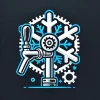Polar is a popular brand for mid-range display fridges in UK cafes and shops. Polar units (sold by Nisbets) are user-friendly and come with digital controllers that show simple error codes (often “E1”, “E2”, etc.). Common issues include sensor faults and cooling problems from blocked condensers, especially in compact countertop models.
Typical Faults & Diagnosis: If your Polar cake display isn’t cooling enough, first verify it’s not an environment issue – these units need ambient below ~32°C and good ventilation. Ensure the thermostat is set to the correct temperature and not in off/defrost mode (Polar controllers may display “OFF” or “def” if in defrost). Frequent cycling or warm temperatures often trace to a dirty condenser or blocked airflow. Polar’s user manual advises cleaning the condenser periodically – disconnect power and brush the coil to remove dust. If the fridge is running but not cold, check for ice on the evaporator; manual defrost may be needed if it’s iced (many Polar units require periodic manual defrosting). Error codes on Polar’s digital display can speed up diagnosis: “E1” means the cabinet’s air sensor is faulty, and “E2” means the defrost (evaporator) sensor is faulty. In either case, the unit might still run but not control temperature accurately. These sensor faults require a replacement probe by a technician. Another common Polar code is “—” (three dashes) which simply indicates the refrigeration is turned off or in standby – ensure the unit isn’t accidentally left in off mode. Polar fridges may also show “HH” or “LL” for extremely high or low temperature readings, often meaning the sensor is out-of-range or the cabinet is far from setpoint (e.g., “HH” could appear if the cabinet goes above 45 °C). In such cases, treat it as an alarm: check if the unit is overloaded or in a too-hot environment and allow it to recover.
Fault Code Table – Polar Displays: (Typical digital controller codes)
| Code | Meaning | Explanation / Solution |
|---|---|---|
| E1 | Faulty air sensor | The cabinet (air) temperature probe has failed or disconnected. Solution: Controller runs in backup mode – sensor must be checked and replaced. |
| E2 | Faulty defrost sensor | Evaporator coil probe failure. Solution: Initiate manual defrost and check the evaporator; replace the probe. Without a working defrost sensor, the unit will defrost on a timed basis. |
| “—” | System Off / Standby | The display shows --- when the refrigeration is turned off via the controller. Solution: Press the power buttons on the controller to resume cooling (exit standby). |
| “def” | Defrost cycle active | Unit is in defrost mode (heater on, compressor off). Solution: Wait – this is normal for cycle defrost; cooling will resume after ~15–20 minutes. |
| E13 | Communication error | Communication fault between display and control board.(uncommon in small Polar units). Solution: Check controller connections; may require control board service. |
| HH / LL | Over-/Under-range temp | “HH” = sensor reading above scale (e.g. >45 °C); “LL” = below scale (e.g. < -45 °C). Solution: Likely ambient extreme or sensor error; verify cabinet conditions or replace sensor. |
References: Polar manual excerpt for error codes, and Nisbets/Polar controller guide for “HH/LL” alarms. The Polar user manual (e.g., models CD229/230) also provides troubleshooting steps like checking power, fuses, and cleaning condensers. Always follow the specific manual for your Polar model.

